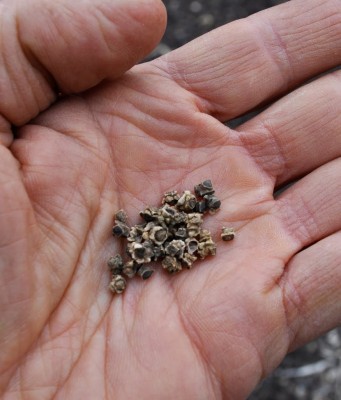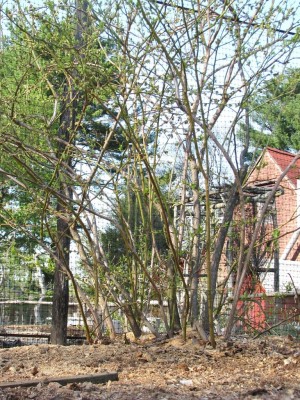Up until a few years ago, I couldn’t get sufficiently empathetic to other gardener’s Japanese beetle woes. That, despite the fact that Japanese beetles are not picky eaters and descend upon gardens almost everywhere. The problem – the empathy problem, that is – was that never more than a few beetles ever made their appearance in my garden.
That situation changed – bad for my garden, good for my empathy – around 2005, when beetle numbers started increasing. Nowadays my garden has annual, full-blown outbreaks of the beetles. Last summer’s rain was good for the beetles’ egg-laying, so problems may be severe this year.

Trapping, milky spore disease, walks over the lawn with spiked shoes, and hand-picking all do their part in limiting beetle numbers, but a recent report tells of another tack: geraniums! Botanically Pelargonium, and specifically zonal geraniums, the ones with the dark zones on their leaves. When Japanese beetles eat geranium flowers or leaves, they become paralyzed for about a day, during which time they’re susceptible to all sorts of predation.
I started thinking about the beetles now, well before they are due to arrive, so that I could start propagating dozens of geranium plants to set out all over my yard this spring. Before beginning, though, I decided to have a chat with Dr. Chris Ranger, the USDA entomologist in Ohio who has been watching beetles keel over following feasts on geranium. It’s a good thing I called because Dr. Ranger quickly pointed out that Japanese beetles won’t eat geraniums unless nothing else is available.
So planting geraniums will not control Japanese beetles. For me, come June, it will be back to hand-picking and traps. On the bright side, geraniums may become a source of a natural, botanical formulation for controlling the beetles. And the flowers are pretty.
——————————————–
The greenhouse is starting to fill up with vegetable seedlings for transplanting. Generally, plants to grow as transplants are tomatoes and others that that need a long season before harvest, and broccoli and others from which you pick a lot from each plant. Root vegetables generally don’t like to be transplanted because their roots want to go straight down deeply, deeper than your average seed flat, before they swell. Any disturbance and the plants die or yield deformed roots.

Beets, however, are one root vegetable that I have been transplanting successfully for a few years. One reason I start beets indoors is because their seeds don’t germinate well. Indoors, I can control moisture and temperature for best germination.
And each beet “seed” is actually a cluster of seeds in a dried fruit, so once they sprout, they come up in crowded clumps. From a seed flat, I can lift individual plants once they have seed leaves and transplant each into its own home in a compartmentalized seed tray.
And finally, some creature – a bird? – always seems to tug out small beet seedlings in the garden. Perhaps the red color in the leaves makes the bird — if the culprit is, in fact, some bird — mistake the seedlings for fruits. At any rate, larger seedlings that I transplant don’t suffer such affronts.
——————————————–
By the end of this week, I’m hoping to have almost all the blueberry bushes pruned, both highbush and lowbush.

On the highbush varieties, I cut a few of the oldest – and, hence, thickest — stems away or to low, vigorous branches using a saw or lopper. Then, using a hand shears and still crouched beneath a bush, I thin out some of the youngest stems wherever they are crowded. After standing back up and snipping back any straggly, gawky, or crowded branches,as well as any that are dead or broken, I’m finished with a bush.

The lowbush blueberries are easier to prune: I just lop all stems back to ground level. The best crops will be borne next year on new shoots that spring forth this year. Those stems yield a lesser crop the following year, and then I start the cycle again by lopping those lowbush blueberry stems way back again.
The problem, of course, is that there are no blueberries to eat each year their stems get lopped back. I’ve solved this problem by dividing the bed in thirds and lopping only a different third of the bed back each year.





Lee, do you have a post about starting a no-dig veg plot?
I’m asked for advice. I always plant everything on top of the grass but not everyone understand this technique.
Thanks.
Chris M.
Not to be commercial, but I wrote a whole book that details the system, everything from why it’s good for gardeners and plants, to starting the plot, to maintaining the plot, to specific instructions for each vegetable, to making or buying compost, etc, etc.. It’s called “Weedless Gardening”. It’s very cheap (less than $10), available through the usual outlets or my website (www.leereich.com); perhaps it’s in your local library.
Thanks for the information, Lee.
I had forgotten the book and will now seek it out.
Happy gardening!
Chris
Thank you so much I’m a novice urban backyard gardener.The information is valuable.